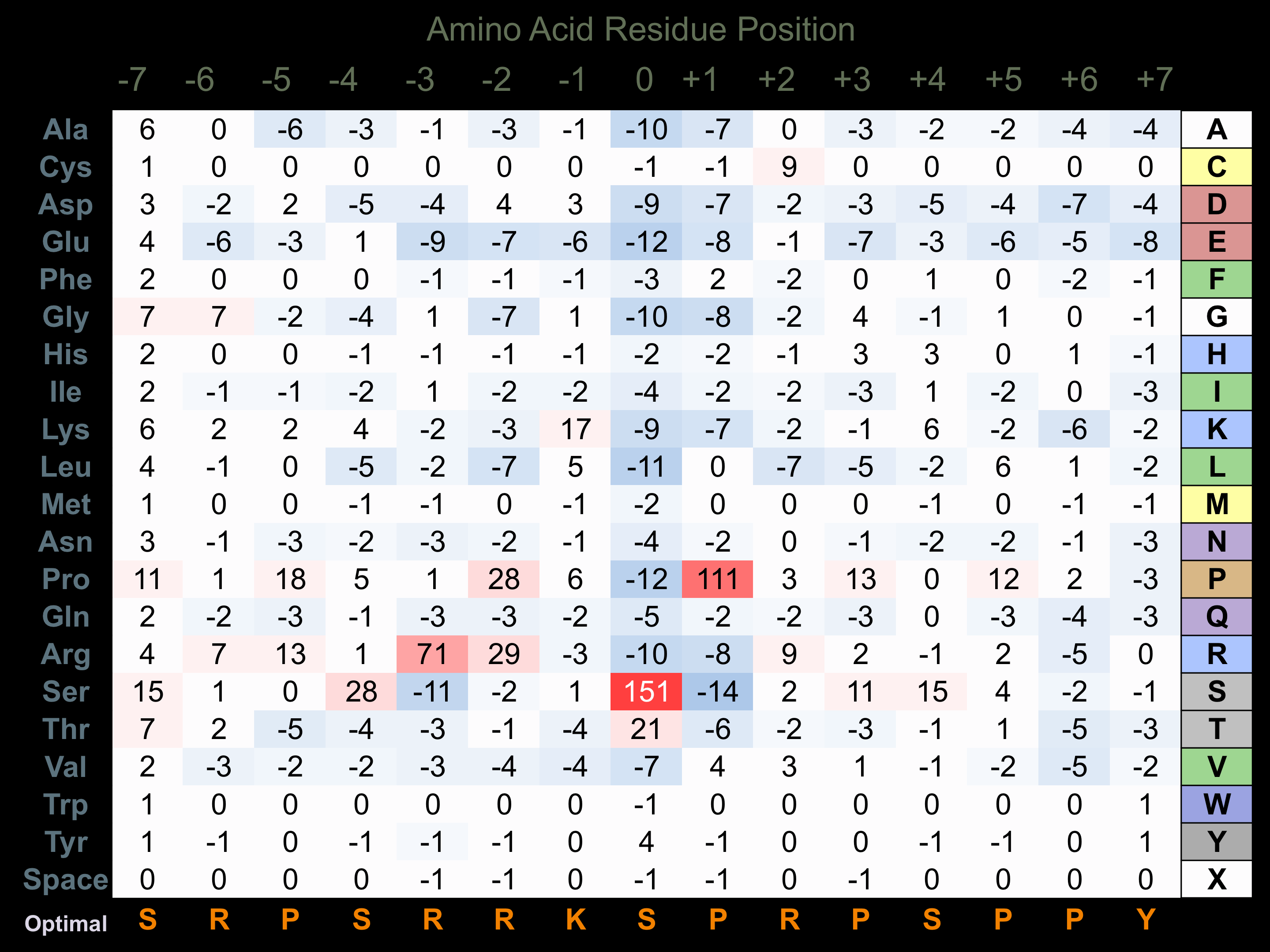Nomenclature
Short Name:
DYRK4
Full Name:
Dual-specificity tyrosine-phosphorylation regulated kinase 4
Alias:
- Dual-specificity tyrosine- (Y)-phosphorylation regulated kinase 4
- EC 2.7.12.1
- Kinase DYRK4
Classification
Type:
Protein-serine/threonine kinase
Group:
CMGC
Family:
DYRK
SubFamily:
Dyrk2
Structure
Mol. Mass (Da):
59,608
# Amino Acids:
520
# mRNA Isoforms:
5
mRNA Isoforms:
73,569 Da (644 AA; Q9NR20-4); 72,577 Da (635 AA; Q9NR20-3); 59,608 Da (520 AA; Q9NR20); 59,537 Da (519 AA; Q9NR20-2); 59,293 Da (517 AA; Q9NR20-5)
4D Structure:
NA
1D Structure:
Subfamily Alignment

Domain Distribution:
| Start | End | Domain |
|---|---|---|
| 104 | 400 | Pkinase |
Kinexus Products
Click on entries below for direct links to relevant products from Kinexus for this protein kinase.
hiddentext
Post-translation Modifications
For detailed information on phosphorylation of this kinase go to PhosphoNET
Acetylated:
K360.
Serine phosphorylated:
S213, S222, S267, S437.
Sumoylated:
K360.
Threonine phosphorylated:
T37, T211, T263+, T445, T457.
Tyrosine phosphorylated:
Y262+, Y264+, Y356.
Distribution
Based on gene microarray analysis from the NCBI
Human Tissue Distribution
% Max Expression:
Mean Expression:
Number of Samples:
Standard Deviation:
% Max Expression:
Mean Expression:
Number of Samples:
Standard Deviation:
 50
50
767
16
987
 6
6
95
10
69
 4
4
59
1
0
 22
22
332
46
506
 47
47
732
14
641
 5
5
78
41
122
 22
22
336
19
531
 49
49
758
20
1196
 22
22
337
10
240
 6
6
100
42
97
 4
4
59
12
40
 41
41
638
105
689
 4
4
57
12
17
 7
7
106
9
95
 6
6
91
10
79
 6
6
98
8
37
 6
6
90
102
38
 5
5
73
8
52
 4
4
67
49
36
 36
36
555
56
575
 9
9
134
10
87
 8
8
120
10
69
 6
6
85
10
30
 37
37
573
8
424
 6
6
87
10
60
 39
39
602
28
726
 4
4
65
15
43
 4
4
63
8
57
 9
9
142
8
85
 6
6
100
14
75
 69
69
1062
18
727
 36
36
561
21
669
 46
46
714
54
977
 52
52
803
31
710
 100
100
1543
22
1125
Evolution
Species Conservation
PhosphoNET % Identity:
PhosphoNET % Similarity:
Homologene %
Identity:
PhosphoNET % Identity:
PhosphoNET % Similarity:
Homologene %
Identity:
 100
100
100
100 97.9
97.9
99
98 89.2
89.2
91.5
88 -
-
-
81.5 -
-
-
- 77
77
81.2
84 -
-
-
- 65.3
65.3
71.5
78 38.7
38.7
53.9
80 -
-
-
- 54.2
54.2
66.2
- 43.2
43.2
59.7
- 28
28
43.3
- 48.9
48.9
61.8
69 -
-
-
- 37.5
37.5
50.1
58 42.4
42.4
59.1
- -
-
-
- -
-
-
- -
-
-
- -
-
-
- -
-
-
- 23.9
23.9
42.5
- 22.7
22.7
36.3
- -
-
-
47
For a wider analysis go to PhosphoNET Evolution in PhosphoNET
Regulation
Activation:
NA
Inhibition:
NA
Synthesis:
NA
Degradation:
NA
Protein Kinase Specificity
Matrix of observed frequency (%) of amino acids in aligned protein substrate phosphosites

Matrix Type:
Predicted from the application of the Kinexus Kinase Substrate Predictor Version 2.0 algorithm, which was trained with over 10,000 kinase-protein substrate pairs and 8,000 kinase-peptide substrate pairs.
Domain #:
1
Inhibitors
For further details on these inhibitors click on the Compound Name and enter it into DrugKiNET or click on the ID's
Based on in vitro and/or in vivo phosphorylation data
| Compound Name | KD, Ki or IC50 (nM) | PubChem ID | ChEMBL ID | PubMed ID |
|---|
Disease Linkage
Gene Expression in Cancers:
TranscriptoNET (www.transcriptonet.ca) analysis with mRNA expression data retrieved from the National Center for Biotechnology Information's Gene Expression Omnibus (GEO) database, which was normalized against 60 abundantly and commonly found proteins, indicated altered expression for this protein kinase as shown here as the percent change from normal tissue controls (%CFC) as supported with the Student T-test in the following types of human cancers: Breast epithelial cell carcinomas (%CFC= +61, p<0.029); Cervical epithelial cancer (%CFC= -52, p<0.0004); Colon mucosal cell adenomas (%CFC= +90, p<0.0001); Skin squamous cell carcinomas (%CFC= -58, p<0.022); and Uterine leiomyomas from fibroids (%CFC= +48, p<0.034). The COSMIC website notes an up-regulated expression score for DYRK4 in diverse human cancers of 597, which is 1.3-fold of the average score of 462 for the human protein kinases. The down-regulated expression score of 49 for this protein kinase in human cancers was 0.8-fold of the average score of 60 for the human protein kinases.
Mutagenesis Experiments:
Insertional mutagenesis studies in mice have not yet revealed a role for this protein kinase in mouse cancer oncogenesis.
Mutation Rate in All Cancers:
Percent mutation rates per 100 amino acids length in human cancers: 0.1 % in 24751 diverse cancer specimens. This rate is only 36 % higher than the average rate of 0.075 % calculated for human protein kinases in general.
Mutation Rate in Specific Cancers:
Highest percent mutation rates per 100 amino acids length in human cancers: 0.45 % in 603 endometrium cancers tested; 0.4 % in 864 skin cancers tested; 0.36 % in 1270 large intestine cancers tested; 0.21 % in 548 urinary tract cancers tested; 0.2 % in 589 stomach cancers tested.
Frequency of Mutated Sites:
None > 6 in 20,034 cancer specimens
Comments:
Very few point mutations in the first 400 amino acid residues. Only 5 deletions, 1 insertion and no complex mutations are noted on the COSMIC website.

